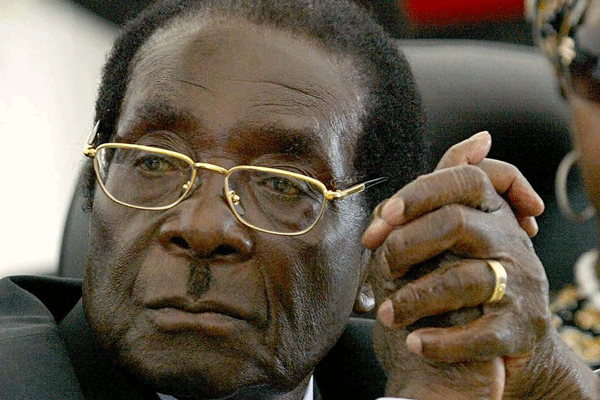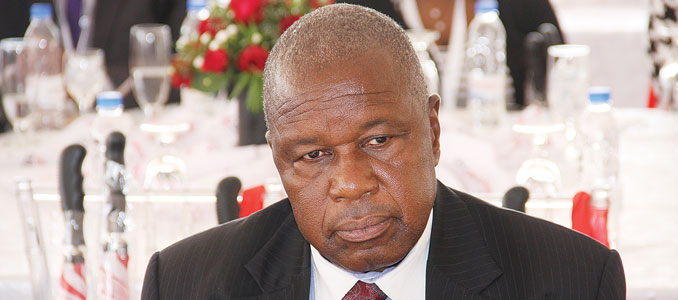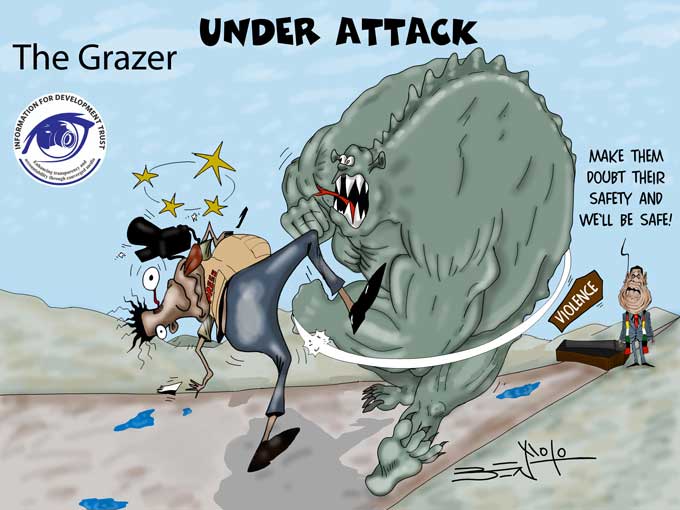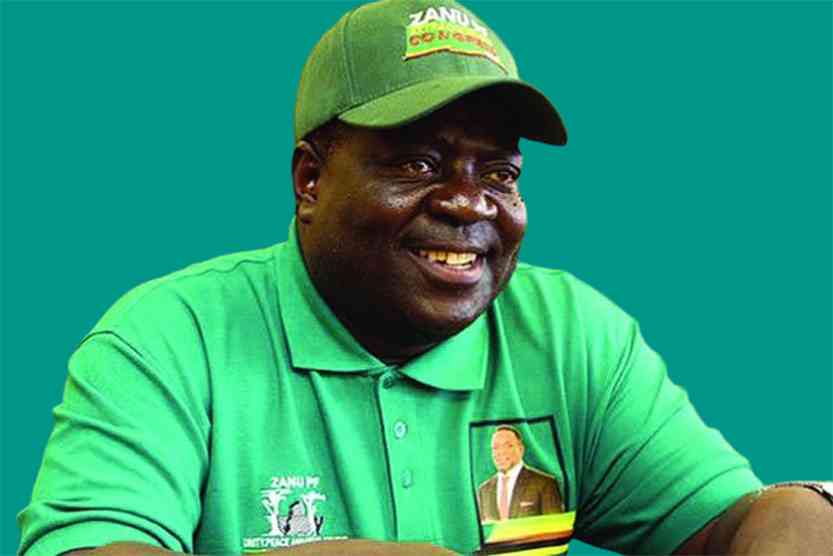
BY TAWANDA MAJONI
Zimbabwe’s former president, Robert Mugabe, died of suspected cancer in the early hours of September 6 in Singapore where he had been receiving medical attention for months.
Aged 95 at the time of his death, Mugabe had ruled Zimbabwe for more than 37 years since independence in 1980, first as prime minister and then executive president from 1987 until he was deposed in a military coup in November 2017.
His tenure as the head of State coincided with an acute shrinkage of media space.
Successive administrations under him routinely refused to open up airwaves to independent players, journalists were persecuted, the profession of journalism was criminalised and there was systematic manipulation of the public media, which were virtually reduced to the ruling party’s and sitting government’s cheerleaders and propaganda platforms.
A close scrutiny of Mugabe’s rule and its repressive relationship with the media—independent and privately owned, formal and social—reveals an obvious tendency.
There was a strong link between the late leader’s quest for political and personal preservation on one hand, and the level of media space he was prepared to compromise.
In other words, the more the political and personal crises Mugabe faced, the greater the control and suppression he applied on freedom of expression and the media.
- Chamisa under fire over US$120K donation
- Mavhunga puts DeMbare into Chibuku quarterfinals
- Pension funds bet on Cabora Bassa oilfields
- Councils defy govt fire tender directive
Keep Reading
This tendency is universally predictable, particularly considering the role that the fourth estate plays.
A free media essentially holds governments to account by, fundamentally, feeding the public domain with news and information that empower citizens, civil society and other players with knowledge of how they are being governed.
A free media tends to reveal the actions and excesses of governments and its officials.
And it also promotes transparency on how those governments, the attending systems and political processes operate or play out.
On the other hand, a government that is experiencing mostly self-made crises and its leaders are averse to free expression and a freely operating media.
They loathe being exposed and seek to thrive and subsist behind a veil of opacity and non-accountability.
As a result, they turn to the media when their own existence and sustainability are threatened by a matrix of crises that may first manifest at the economic level and then degrade into the political sphere.
This narrative is typical in, and symptomatic of, authoritarian and repressive regimes globally and throughout history.
One of the world’s most notable dictators, Adolf Hitler, destroyed more than 3600 newspapers within 11 years from 1933 when he took over power.
He created a propaganda ministry that persecuted radio stations and newspapers and heavily censored the media, in addition to suppressing film, theatre and un-Aryan literature.
Even after Hitler’s demise and the creation of the United Nations which produced the Universal Declaration of Human Rights in 1948—notable of which is Article 19 that gave everyone the right to hold opinions without interference and to seek, receive and impart information and ideas through any media—violation of that fundamental right has persisted, mainly among oppressive governments in Africa, Eastern Europe, Asia and South America.
Mugabe’s methods of media repression
The Mugabe dispensation employed a complex but common cocktail of tactics to repress media freedom.
In essence, this repression entailed discouraging and confronting pluralism in broadcasting and print media, undermining journalistic independence, failure to guarantee, and encouraging an onslaught on the safety of journalists.
This was in addition to the virtual criminalisation of the journalism profession and the employment of negative propaganda as well as the generation of a negative perception of the media.
More particularly, Mugabe’s successive governments repeatedly resisted attempts to license independent radio and television stations at the community, regional and national levels.
Mugabe perpetuated colonial monopoly of State television, and this remains the case to this day.
Regarding the licensing of radio stations, his administration employed a strategy of deception.
While at least 10 national and regional, purportedly “independent”, radio stations were licensed from 2012, the truth is that if these are not overtly government-controlled, they are run by proxies of government and the ruling Zanu PF.
This proceeds from the reality that, invariably, ex-president Mugabe always sought to manipulate media content to his, the ruling party’s and government’s advantage.
This is reflected in how the government-controlled media have remained under the heavy influence and bearing of the Information ministry, ad hoc official interference and sometimes ruling party interjections, through staff appointments, the control of news pitches and in-house public media regulations and rules.
Thirdly, Mugabe’s tenure of power was marked by repeated and substantially horrific arrests, torture, illegal detentions, abductions of and verbal as well as physical and mental assaults on local and international journalists and other media practitioners.
This was designed to generate fear, self-censorship and a spirit of resignation among media practitioners.
This mostly applied to independent journalists, but there were notable cases of such in the public media too.
Fourthly, numerous media houses considered to be non-compliant with the expectations of Mugabe’s rulership were systematically shutdown or bombed, while a raft of w4estern newswires, among them CNN, BBC, Sky News, CBC, ABC, Channel 4 and Fox News were banned from operating from within the country.
Typical of authoritarian regimes in Africa and elsewhere, the Mugabe administration also employed legislative repression.
When Zimbabwe attained independence in 1980, it inherited and retained two notable oppressive legislations used by the apartheid Rhodesian government of Ian Smith, namely the Official Secrets Act (OSA) that made it criminal to publish “classified” government information, and the Law and Order Maintenance Act (Loma) that contained a number of sections that constrained publication of information and news by journalists.
The Loma was re-worded into the Public Order and Security Act (Posa) in 2002.
Under Posa, it became criminal to “undermine the authority of the president”, publish falsehoods, generate disaffection of and within the police and use “indecent”, abusive” and “false” statements against the president.
While the constitution provided for freedom of expression and the media, in line with regional and continental as well as the United Nations’ Universal Declaration of Human Rights, these provisions in Posa severely constrained media content generation and publication.
Other laws that undermined media freedom were the Broadcasting Services Act (2000) that made it illegal to broadcast without a licence and provided the opportunity to a government agency, the Broadcasting Authority of Zimbabwe (BAZ), to exclude independent media players and the Access to Information and Protection of Privacy Act (Aippa, 2002), that was passed just before the 2002 presidential elections and coinciced with a flurry of arrests of journalists, media closures and expulsions.
International indices on media freedom
As already noted and will be explained later, media repression under Mugabe manifested in direct proportion to the political and personal crises that the former president and his administration faced.
World press freedom indices by Reporters without Borders (RSF) partially but substantially provide telling insights into this negative correlation.
RSF commenced producing these indices in 2002, the year that Zimbabwe held its first presidential election since the formation of the Movement for Democratic Change (MDC) that was represented by the late Morgan Tsvangirai who presented the biggest power challenge to Mugabe since 1980.
In the same year, Zimbabwe’s generals held a press conference at which they announced that they would never salute a president without war of liberation credentials, implicitly ruling out Tsvangirai and hinting at a coup if the popular opposition leader won against Mugabe.
It was also the same year that RSF was banned from carrying out its studies in Zimbabwe.
RSF interviews targeted samples of the population and harvests their perceptions on media pluralism, safety and security of media practitioners, journalistic independence, freedom of the media, relevant laws and the availability and accessibility of related infrastructure.
RSF carries out its studies in an average of 180 countries across the globe.
In 2002, Zimbabwe was ranked at 123, meaning that it fared better than only 57 countries.
There was an acute decline in 2003, when the country fell to 143, then peaked at 156 the following year.
It stood at 153 in 2005 and, by 2008, it was at 151. This represents the period when media freedom in Zimbabwe was at its lowest.
There was a general improvement from 2009, when, following severely disputed elections in 2008 and widespread political violence, the ruling Zanu PF agreed the government of national unity (GNU) with two MDC factions led by Welshman Ncube and Arthur Mutambara, respectively.
In 2012, just before the GNU expired, Zimbabwe was standing at 117, its best ranking so far.
But it slid fast in 2013 when the GNU expired and Zanu PF and Mugabe, again, won the contested general elections with a majority.
It fell 16 places in one year. By 2017, when Mugabe was deposed, it was standing at 127.
Mugabe’s shades of crisis and media repression
Mugabe and his successive governments faced varying phases of political and economic pressure.
The first distinct phase is from 1980 to 1987. As executive prime minister, Mugabe inherited an uneasy political dispensation from Ian Smith after the first majority elections following British-mediated talks that culminated in the transitional Lancaster House constitution in December.
The major political parties, Zanu PF and PF Zapu, had a socialist-communist orientation but these two were estranged bed fellows despite a unity government at the beginning.
By 1982, there were major cracks in the coalition government that also sought to absorb remnants of the Rhodesian Front in the military and civil service.
Largely regionalised civil disturbances broke out in southern Zimbabwe when Mugabe accused PF Zapu of training and deploying dissidents.
Mugabe led a crackdown on the region, Gukurahundi, resulting in the deaths of at least 20,000 mainly non-Shona speaking people, according to the Catholic Commission for Justice and Peace (CCJP).
Widespread killings occurred until 1987 when, through the mediation of the late ceremonial president, Canaan Banana, Mugabe hammered out another coalition with the PF Zapu leader, Joshua Nkomo, through the Unity Accord that folded the two major parties into Zanu PF.
During this phase, there were a few documented cases of media persecution.
Even though there was a couple of independent media houses such as The Moto and The Parade, the mainstream media was dominated by government-controlled outlets in the form of the Zimpapers stable, State radio and State television, together with the Mass Media Trust.
Just as in the case of the previous colonial government, the official media retained its role as government mouthpieces.
That role was obvious during the Gukurahundi disturbances when the public media suppressed information on the killings and painted a saintly picture of the government that was apparently recording major socio-economic successes.
At that time, it was, however, rare to hear of journalists being abducted or tortured.
Several factors can plausibly explain this.
Despite his claims that Zimbabwean political stability was under threat due to the disturbances in the south, Mugabe was clearly convinced that he was in charge of the situation.
He remained a darling of the West, particularly Britain, which conveniently ignored the genocidal commissions and continued to pamper him with humanitarian and financial support.
Besides, he was also receiving strategic support from the communist bloc in Eastern Europe.
There was a dominant narrative of Mugabe being a phenomenal, intelligent and able leader, so the ego and arrogance for which he was well-known remained largely intact.
And he enjoyed the stable and wise counsel of his first wife, Ghanaian Sally Mugabe.
Public media dominated the landscape, hence the most notable poverty relating to media freedom centred on the manipulation and regulation of journalists.
The second phase stretches from the late 1980s to the mid-1990s.
The United Soviet Socialist Republic (USSR) disintegrated under Mikael Gorbachev, effectively removing the main support base for Mugabe’s professed socialist ideology and ideals that included the one-party State.
The disintegration of the USSR left the USA as the sole global power.
Because of repeated political miscalculations that included an increasing tendency towards dictatorship and corruption, Mugabe was facing public revolt from war-time allies such as Edgar Tekere who went on to form the Zimbabwe Unity Movement (ZUM) and stood in elections against Mugabe.
University students were becoming increasingly critical of him.
Sally became critically ill, his mother, Bona, passed away and he had to live with the festering frustration that he could not bear children with his official wife.
The Bretton Woods institutions, the World Bank and the International Monetary Fund (IMF) convinced him, despite internal opposition, to adopt an Economic Structural Adjustment Programme (ESAP), with disastrous consequences.
Coming on the back of devastating droughts, ESAP led to massive job losses, rising prices, shortages of commodities and general disgruntlement.
Mugabe’s relationship with the media during this period was curiously ambivalent.
One of the public media houses, The Chronicle, in 1089 published a series of stories on the Willowgate scandal that involved cabinet ministers and senior authorities corruptly selling cars obtained under a subsidised programme.
He even invited State media editors for a debrief during the Willowgate exposes and succumbed to pressure to resign some of his favourite ministers.
But The Chronicle editor then, Geoff Nyarota, and his deputy, Davison Maruziva, were removed from their positions after the meeting with Mugabe, implying that he could have been angered by their muckraking, which had a negative bearing on his political rating as a leader.
During this period, Mugabe hardly received condemnation for constricting media space.
The public media dominated in reach, form and quantity and there were minimal public concerns about the manipulation of government-controlled news outlets.
Even though the economy had received a hard knock from ESAP, Mugabe seems to have remained convinced that he was firmly in control and could solve the problems that he was facing politically.
The situation for him as an individual and his government quickly degenerated between 1985 to 1999.
Civil society was getting stronger and criticism of his style of government louder.
Several independent publications—The Standard, and the Daily Gazette—were established.
During this period, Mugabe made two notable political blunders.
Without consulting Parliament and the majority of his colleagues in the Southern African Development Community (Sadc), he deployed the army to prop the government of President Laurent Kabila in the Democratic Republic of the Congo (DRC) against an insurgency.
The operation, independent estimates indicated, cost Zimbabwe around US$1 million a day.
Mugabe also gave unbudgeted gratuities worth millions to veterans of the armed struggle against colonial rule.
The value of the local dollar crushed steeply.
During the same phase, prices of commodities rose sharply, there were shortages of goods and the population became restless as the Mugabe government was confronted with the angriest protests ever witnessed since independence.
Civil society rode on the rising discontent and converged with labour to form the Movement for Democratic Change that gave Mugabe the most popular and strongest challenge he had ever confronted.
Then, the ex-president threw down the gauntlet and removed the first glove against particularly the new independent media as pressure against his government mounted.
In early 1999, for instance, The Standard exposed growing internal disgruntlement when it reported that some soldiers had been arrested for plotting a coup against Mugabe.
The military arrested and tortured the editor, Mark Chavhunduka, and the reporter, Ray Choto, who later fled into exile.
The next phase covers the period 2000 through 2008. One of the most critical newspapers, Daily News, was established in 2000.
Mugabe’s government embarked on an internationally condemned fast track land reform programme that was perceived as a populist tactic to regain lost support.
Both The European Union (EU) and the US imposed what they called targeted restrictive measures against Mugabe and his lieutenants, together with business enterprises that were seen as closely aligned to government of the day.
Zimbabwe was suspended from the IMF and World Bank and became markedly isolated internationally.
At an individual level, the media began to produce negative reports on Mugabe’s health, the paternity of his children, his wife’s alleged adulterous life and reported accumulation of ill-gotten wealth.
The economy deteriorated tremendously, companies shut down, unemployment rose to unprecedented levels and political unrest peaked amid electoral fraud and massive human rights abuses.
The year 2008 represents the peak of the political-economic crisis when goods virtually disappeared from the shelves, there was a cholera outbreak that coincided with extreme power and fuel scarcities and Mugabe lost to Tsvangirai in the first round of elections in March, forcing a Thabo Mbeki-mediated Global Political Agreement (GPA) that paved the way for the GNU in early 2009.
As indicated by the RSF media freedom indices during this period, 2000 to 2008 represents the worst media repression Zimbabwe has suffered in the new millennium.
That was the era when the most suppressive laws were enacted, namely the Broadcasting Services Act, Aippa and Posa.
The last seems to have been crafted to not only muzzle free reportage, but to cushion Mugabe against journalistic reports on his private life.
The Daily News and Voice of the People (VOP) were bombed and several newspapers were shut down while international news outfits were banned from reporting from Zimbabwe.
There were several arrests, abductions and torture of media practitioners and many fled the country.
From 2009 and 2013, while the restrictive laws were retained and harassment of journalists continued, media practitioners enjoyed relatively freer space.
The economy stabilised and the coalition with the opposition apparently revived international appetite to re-engage the Zimbabwean government.
While there were continual bickering within the GNU, Mugabe seems to have regained some ground and was under pressure to lead in the democratisation of the country.
But once Mugabe and Zanu PF were left alone after the expiry of the GNU and the general elections of 2013, the economy went on a free fall again and there was renewed international pressure against the government. There was also a spike in media demonisation and persecution.
It is, therefore, clear that Mugabe loved his power and person too much to care for the media, and whatever “reforms” and loosening of space that occurred during his time were for self-serving purposes.
This article was first published by The Accent, a Media Alliance of Zimbabwe initiative










